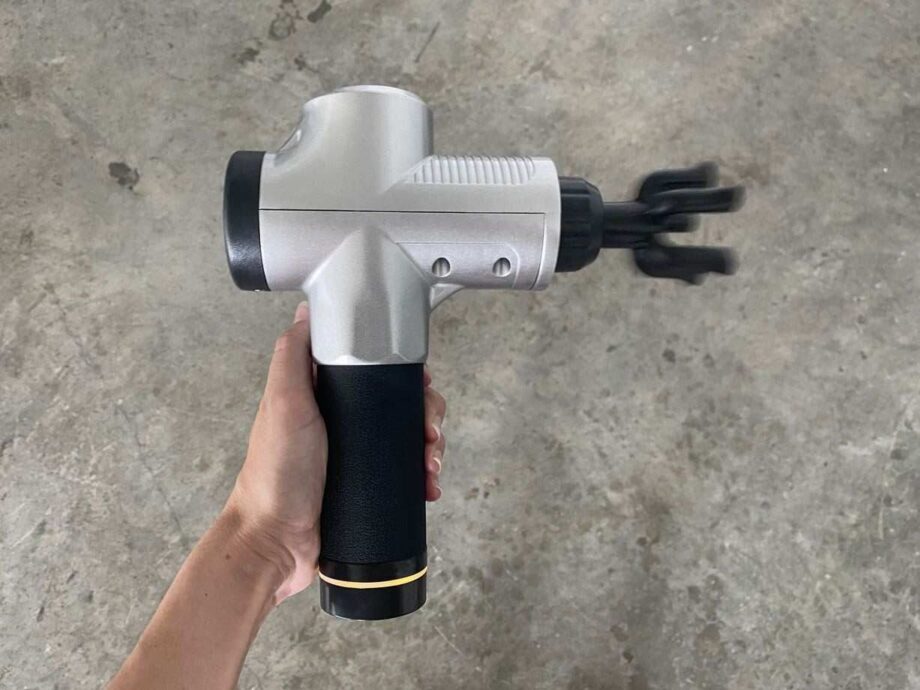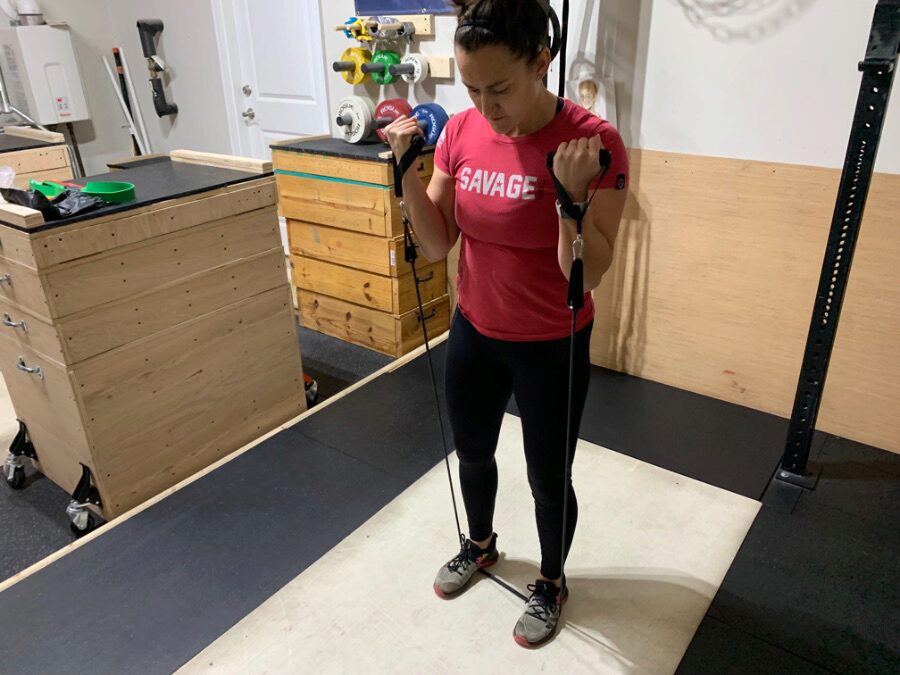What’s not to love about having strong shoulders? Strong shoulders enhance our athletic performance, allowing us to generate more force when we throw a baseball, serve a tennis ball, or throw a left hook.
But there are also loads of everyday tasks that strong shoulders facilitate. Activities like lifting and carrying objects, reaching for stuff on shelves, and rearranging furniture.
Having strong shoulders makes living less easier and more pain-free, so it’s important to target and exercise the shoulder muscles, specifically the deltoids since they are the prime movers of the best shoulder exercises.
If you’re ready to build your shoulders, you definitely have to check out our list of the best deltoid exercises and work them into your next session!
Deltoid Anatomy
You have a few different muscle groups in the shoulders, including the deltoids, trapezius, levator scapulae, and rotator cuff muscles.

Our exercises today will target the deltoids1 because they are prime movers of most shoulder exercises. The deltoid muscle group includes three distinct regions:
- The anterior deltoids
- The lateral deltoids
- The posterior deltoids
“Your delts not only provide support to the shoulder joint, they also enable a variety of arm movements, including shoulder flexion, extension, and abduction,” says Kate Meier, certified personal trainer and GGR head of content. How, specifically, you move your arm determines which deltoid receives the most muscle activation.
RELATED: The Best Shoulder Workouts With Dumbbells
How to Target the Deltoids
According to a 2020 study published in the Journal of Human Kinetics2, you’ll get significantly more deltoid muscle activity during shoulder exercises, like the overhead press and lateral raise, than during dumbbell chest exercises like the bench press and dumbbell fly.
That’s not to say you won’t get delt activity during certain chest-centric exercises, so they will have a place in our delt workout along with more targeted delt exercises.

What’s most important about this study was that researchers found that different types of shoulder exercises provided different types of stimulation in the deltoid muscle group. Presses focused on the front deltoids, while lateral raises hit the medial deltoids on the side of the shoulder.
So, if you’re looking to target each region of the deltoid muscle equally, incorporating shoulder movements like shoulder presses, raises, and even a few chest and back exercises will hit the muscle from all angles and lead to the best all-around growth.
These Are the Best Deltoid Exercises of All Time
Are you ready for the best exercises for stronger shoulders?
Without further ado, we’re laying down our list of the top deltoid exercises to add into your next session. Fill your water bottle, get in your warm-up, and let’s get to work!
Military Press
Why it’s great: A strict military press (often called a shoulder press or overhead press) is often the cornerstone of an all-encompassing shoulder workout. The movement itself provides activation in the anterior and lateral deltoids, as well as the trapezius and triceps, and using a barbell makes it easy to really go heavy!
How to do it:
- Load a barbell to your desired weight and unrack it into the front rack position. You want your feet shoulder-width apart and your hands slightly wider than that with the elbows pointed forward.
- With your back straight and core braced, press the bar overhead.
- After you reach full elbow extension, pause, then slowly return to the starting position.
- Repeat as needed.
RELATED: The Best Barbell Exercises

Seated Barbell Overhead Press
Why it’s great: As the barbell gets heavier and heavier, we run the risk of cheating the movement and turning our strict press into a push press, or otherwise using body English to get that bar overhead. “Having a seat takes away your ability to do that, making sure you really keep the focus on the shoulders,” explains certified personal trainer Kate Meier.
One variation of this, the Z press, is shown here, though you can also sit on a bench and perform this exercise.
How to do it:
- Sit down on a weight bench with your back firmly against the support pad.
- Unrack a loaded barbell into the front rack position.
- Press the bar overhead, pushing your back into seatback and your feet into the floor.
- Pause at the top, then slowly return to the starting position.
- Repeat as needed.
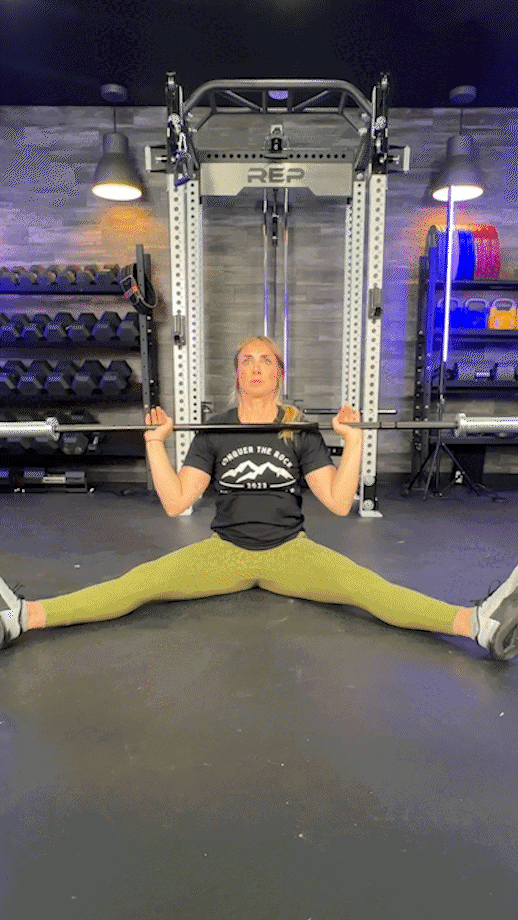
Dumbbell Overhead Press
Why it’s great: How do we get all the perks of the barbell overhead press but with a greater range of motion and greater muscle activation? Trade out the barbell for a pair of the best dumbbells!
How to do it:
- Hold two dumbbells at shoulder height using either an overhand grip or neutral grip.
- Press them overhead until your arms are locked out with your hands over your shoulders (not in front of them). You can alternate pressing, or press both at the same time.
- Return to the starting position.
- Repeat as needed.
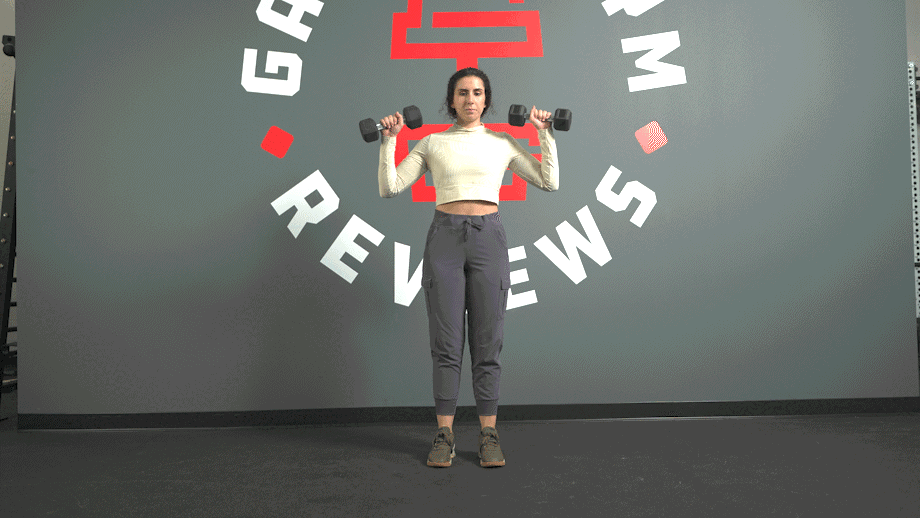
Seated Dumbbell Overhead Press
Why it’s great: We love lifts like the dumbbell overhead press while standing, since you get some added activation in the lower back, glutes, and core, but sitting down keeps the focus on the shoulders where it should be.
How to do it:
- Have a seat on a bench with your back firmly against the support pad.
- Hold a dumbbell in each hand at shoulder level using your choice of an overhand grip or neutral grip, then press them overhead until your arms are locked out.
- Slowly return to the starting position.
- Repeat as needed.

Arnold Press
Why it’s great: Former bodybuilder-turned-Terminator-turned-governor Arnold Shwarzenegger was known to use this unique variation of the overhead press because of how it challenges the front delts and upper arms. Try it out and it’ll have you saying, “I’ll be back!”
How to do it:
- From a standing position, grab two dumbbells and hold them in front of your shoulders with your palms facing your face.
- Rotate the dumbbells while pressing them overhead. You should finish with the dumbbells overhead, arms fully locked out, and your palms facing away from your body..
- Slowly return to the starting position, reversing the rotation as you go.
- Repeat as needed.
RELATED: The Best Back and Shoulder Workout

Dumbbell Lateral Raise
Why it’s great: The dumbbell lateral raise is the quintessential isolation exercise for your middle deltoids. You’ll feel this mostly in your delts, but you do get a little activation in the anterior deltoid and upper trapezius, too.
How to do it:
- Stand with your feet hip-width apart and your arms at your sides, holding a dumbbell in each hand. You want a slight bend in the elbow to protect it from shear force.
- Raise your arms outwards until they are approximately shoulder height.
- Squeeze your shoulders, then slowly return to the starting position.
- Repeat as needed.

Dumbbell Front Raise
Why it’s great: Front raises are another shoulder day staple. Performing these bad boys provides ample activation of the anterior delts, a muscle that is notoriously difficult to hit.
How to do it:
- Grab two dumbbells with an overhand grip and hold them in front of your body from a standing position. Be sure to keep a slight bend in the elbow.
- Raise your arms upwards until they are at shoulder level.
- Squeeze your shoulders, then slowly return to the starting position.
- Repeat as needed.

Dumbbell Reverse Fly
Why it’s great: Wait a tick— aren’t reverse flyes one of the best back exercises? Well, yes, but that doesn’t mean they’re not great for activating the often-overlooked rear delts, making them a must for any upper body focused workout.
How to do it:
- From a standing position, grab two dumbbells, then bring your hips back, lowering your chest towards the floor while keeping your back straight. Brace your core to stabilize the torso, then let your arms dangle straight down in front of you. This is your starting position.
- Keeping a soft bend in the elbow, pull the dumbbells up and out simultaneously, pinching your shoulder blades at the end of the movement.
- Slowly return to the starting position.
- Repeat as needed.

Face Pulls
Why it’s great: Swapping free weights for the cable machine on this exercise helps us target the rear deltoids, upper back, and rotator cuff muscles, which are crucial for maintaining shoulder stability. If you don’t have access to a cable machine, you can perform face pulls with an anchored resistance band.
How to do it:
- Attach the rope attachment to the cable machine and set it to shoulder height.
- Using an overhand grip, grab both ends of the rope and step back until your arms are fully extended. You want your shoulders down and back, chest up, and core tight.
- Pull the rope toward your face, pinching your shoulder blades together as you go.
- Pause, then return to the starting position with control.
- Repeat as needed.
RELATED: How To Do Face Pulls
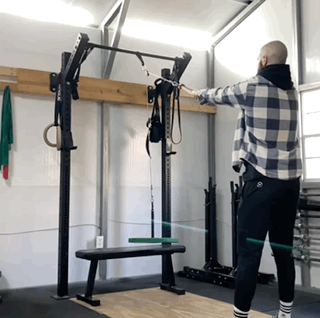
Barbell High Pulls
Why it’s great: Take the controlled and deliberate upright row and add a little explosiveness, and that’s your barbell high pull in a nutshell. This one will get your rear delts, traps, and upper back muscles while hiking that heart rate higher.
How to do it:
- Hold a barbell in front of your body.
- Bend your knees and bring your hips back, then shoot upward and pull the barbell toward your chin by extending the hips, knees, and ankles simultaneously.
- Control the bar’s descent and dip to absorb momentum and cycle into the next rep.
- Repeat as needed.

Wide Grip Bent-Over Row
Why it’s great: The bent-over row mostly works your lats, traps, and rhomboids, but you’ll also hit the posterior deltoids. According to a 2021 study published in the International Journal of Environmental Research and Public Health3, a wider grip on the bar will increase muscle activation in the deltoids.
How to do it:
- Place a barbell on the floor and load it to the desired weight. Stand over it with your feet roughly shoulder-width apart, then bend down and grip it with an overhand grip that’s wider than your standard grip.
- Squeeze your shoulder blades together and pull the barbell toward your torso. You want the bar to lightly tap somewhere between your bellybutton and your sternum.
- Control the bar’s descent until your arms are fully extended.
- Repeat as needed.
RELATED: The Best Bent-Over Row Alternatives

Inverted Row
Why it’s great: Inverted rows aren’t just for pull-up practice. They’re also just all-around great for hitting various muscle groups, like the lats, traps, rhomboids, and posterior delts, using only your own bodyweight as resistance.
How to do it:
- Secure a barbell to the J-hooks of a squat rack or power rack. You want the bar at approximately hip height.Then, sit on the floor grab the bar using an overhand grip.
- Walk your feet out to set your preferred level of difficulty. The closer your legs are to the bar, the easier the exercise will feel.
- Pull your chest to the bar, squeezing your back muscles as you move.
- Pause at the top of the movement, then slowly return to the starting position.
- Repeat as needed.

Incline Bench Press
Why it’s great: So, the incline bench press is predominantly for your pecs and triceps, but you’ll also get activation in the anterior deltoid, helping you shape and strengthen your shoulders.
How to do it:
- Set an incline bench between 30- and 45-degrees and have a seat.
- Grab a barbell with an overhand grip that’s slightly wider than shoulder-width.
- Lower the bar to your upper chest slowly, then push it back up.
- Squeeze your pecs at the top of the movement, then cycle into the next rep.
- Repeat as needed.

How to Create a Shoulder Workout
So, we have a great list of shoulder exercises, but now we need to put it all together into a cohesive workout that will provide activation in all the right places and get results.
How many reps to build muscle? How heavy do we have to go to build strength? What’s a good number of sets and reps? Well, that all depends on your goals.
For our answers, we’re turning to a study published in 2002 in the European Journal of Applied Physiology4, which involved three distinct groups of participants:
- A low-rep group that performed few reps using heavy weights
- A high-rep group that performed many reps using light weights
- An intermediate-rep group that performed some reps using moderate weights
The study concluded that “maximal strength improved significantly more for the low-rep group” while “maximal aerobic power and time to exhaustion significantly increased at the end of the study for only the high-rep group.”

Basically, you want to bang out three to five heavy reps per set if your goal is to get stronger, while racking up double digits worth of reps using lighter weights instead improves muscular endurance.
If you want to build muscle mass, on the other hand, keeping the number of sets and reps right down the middle, about three to five sets of eight to 12 reps, should work well.
For more personalized programming, consider working with a certified personal trainer or other qualified fitness professional.
Best Deltoid Exercises: FAQs
How can I strengthen my deltoid muscle?
Incorporating a handful of our best delt exercises are your blueprint for stronger shoulders, but is there anything else we can do to support our success?
Shoot for less sets and reps while using heavier weights while in the gym.
Approximately three to five sets of between one and five reps should do the trick.
Practice proper form during the entire range of motion, but be sure the weight feels challenging on just about every rep.
Once you’re wrapped up at the gym, you’ll want to support your recovery by drinking water, eating plenty of lean protein to encourage muscle repair, and getting enough sleep.
At the end of the day, what we do in the gym is very important, but what we do in between training sessions is just as, and arguably more, crucial to our success.
How do you target all three delts?
Dumbbell presses, Arnold presses, and barbell presses are a great place to start, but no single exercise specifically targets all three deltoid muscles the way you might want it to. Therefore, including multiple exercises that get your shoulder muscles from different angles will help make sure your approach is comprehensive and you enjoy well-rounded results.
How often should you hit delts?
It’s tempting to hit the same muscle groups over and over when we’re eager to see results, but that’s only going to leave you feeling beat up and ultimately increase your risk of injury instead.
You need to give the body enough time to fully recover before targeting the same muscle group. We recommend roughly 48 hours in between training sessions, so your delts will be at 100% the next time you target them.
References
1. Elzanie A, Varacallo M. Anatomy, Shoulder and Upper Limb, Deltoid Muscle. [Updated 2023 May 8]. In: StatPearls [Internet]. Treasure Island (FL): StatPearls Publishing; 2023 Jan
2. Campos YAC, Vianna JM, Guimarães MP, et al. Different Shoulder Exercises Affect the Activation of Deltoid Portions in Resistance-Trained Individuals. J Hum Kinet. 2020;75:5-14. Published 2020 Oct 31. doi:10.2478/hukin-2020-0033
3. Saeterbakken AH, Stien N, Pedersen H, Solstad TEJ, Cumming KT, Andersen V. The Effect of Grip Width on Muscle Strength and Electromyographic Activity in Bench Press among Novice- and Resistance-Trained Men. Int J Environ Res Public Health. 2021;18(12):6444. Published 2021 Jun 14. doi:10.3390/ijerph18126444
4. Campos GE, Luecke TJ, Wendeln HK, et al. Muscular adaptations in response to three different resistance-training regimens: specificity of repetition maximum training zones. Eur J Appl Physiol. 2002;88(1-2):50-60. doi:10.1007/s00421-002-0681-6





